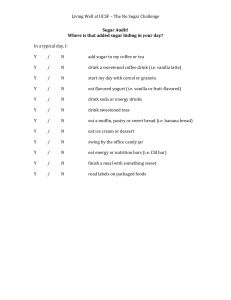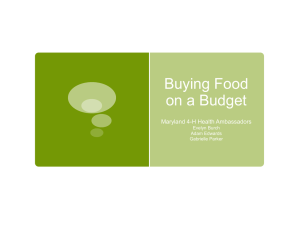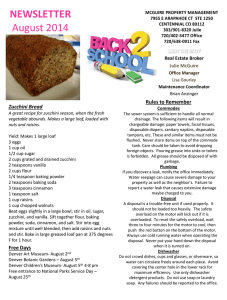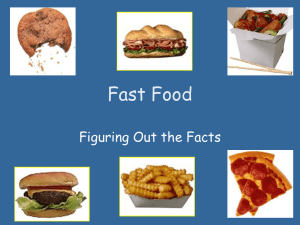The Great Sugar Shake Up (Powerpoint)
advertisement
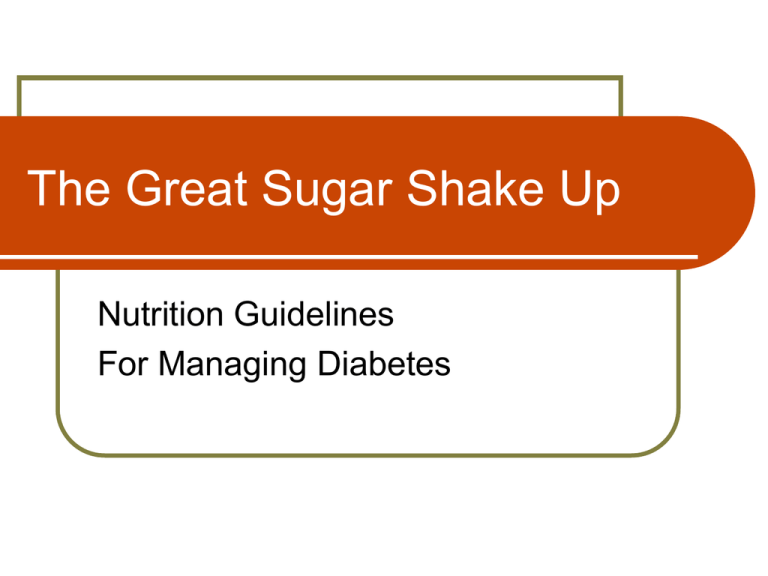
The Great Sugar Shake Up Nutrition Guidelines For Managing Diabetes Sugar Shake Up Babs Carlson, PhD, RD, CDE Coordinator, DSMEP Lifestyle Center Chesapeake Regional Medical Center Retired Diabetes 24 million Americans have Diabetes – 8% of the population (1 in 12) 57 million Americans have pre-diabetes20% of the population By 2020, 20% of the population will have Diabetes 34% of babies born after the year 2000 will develop Diabetes in their lifetime Diabetes Diabetes cost the nation $174 billion in 2008 1 in every 8 dollars spent on healthcare is attributed to Diabetes (12%) Diabetes 50% of Black and Hispanic Americans over age 50 have Diabetes or Prediabetes 40% of white/ Caucasian Americans over age 50 have Diabetes or Prediabetes Obesity 66% Americans are Overweight 34% Americans are Obese: BMI>30 50 years ago, 20% of Americans were overweight. Some experts predict that by the year 2099, 99% of Americans will be overweight Obesity Why the Increase in Obesity? Why the increase in Visceral Obesity ie Insulin Resistance ie Beta Cell Failure Obesity Consumption of calories as Fat has remained steady since 1980s Consumption of calories as Sugar has increased from 129 pounds per person in 1980 to 148 pounds per person in 2005 Sugar consumption now as high fructose corn syrup contributes to Diabetes and triglycerides Sugar Shake Up Why Sugar? Sugar does not cause Diabetes. ADA: “substituting sucrose containing foods for isocaloric amounts of other carbohydrates will have similar blood glucose effects” Sugar Shake Up Sugar does deliver excess calories with no satiety value ADA: “People with diabetes should avoid intake of sugar-sweetened beverages to reduce the risk for weight gain and worsening cardiometabolic risk profile.” Sugar Shake Up Dietary Guidelines: Reduce added sugars intake to 4 – 10 teaspoons per day Sedentary females: 4 teaspoons Active males: 10 teaspoons 1 teaspoon = 4 grams of sugars Sugar Beverages – 12 ounces Apple juice – 7 teaspoons Energy Drink 10.5 teaspoons Orange juice 7 teaspoons Pepsi 11 teaspoons Coke 9 teaspoons Gingerale 9 teaspoons Vitamin Water 5 teaspoons Sugar Beverages 7-11 Slurpee 6 teaspoons (ice) Big Gulp 12 teaspoons Sweet tea 6 teaspoons Latte 7 teaspoons Tazo Chai Frappuccino 14 teaspoons Tropical Smoothie 12 teaspoons Gatorade 6 teaspoons Powerade 8 teaspoons Sugar Foods Instant oatmeal 4 teaspoons Blueberry muffin 5 teaspoons Chocolate chip cookies 2 teaspoons Glazed donut 5.5 teaspoons Sherbet 5 teaspoons Fruit Yogurt 7 teaspoons Mars bar 7 teaspoons Sugar Calorie Sources Top calorie sources for Adults Grain-based desserts Yeast breads Soda/ energy drinks Dairy desserts Sugar Shake Up If not Sugar, then WHAT? Follow the A, B, C’s HbA1c = Average Blood Glucose: 6.5 Blood Pressure: 130/80 Cholesterol Tchol Trig HDL LDL <200mg/dl < 150mg/dl > 40 >50mg/dl < 70mg/dl Nutrition Guidelines Eat Breakfast every day Breakfast should be eaten within 60 minutes after getting out of bed Breakfast should be eaten before exercise Breakfast should include Protein Last meal should be eaten prior to 2 hours before going to bed Nutrition Guidelines Carbohydrates – greatest impact on post prandial blood glucose Protein – building block for insulin, provides satiety, necessary in each meal Fat – delays gastric emptying, plant sources necessary daily Salt as sodium – 1500 - 2300 mg daily Nutrition Guidelines Carbohydrates should provide 45-60% of calories per meal, per day 1500 calories: 1800 calories: 2400 calories: 185 grams 225 grams 300 grams Minimum daily recommendation is 135 grams distributed among 3 meals, snacks if necessary Nutrition Guidelines Carbohydrate sources Vegetables: 4-5 servings daily Fruits: 2-3 servings unless triglycerides elevated. Fruit not juice Whole grains should provide 2-3 grams fiber per serving Cereals should provide 3 grams fiber per serving Fiber total: 25 grams daily Nutrition Guidelines Protein should provide 12-20% of calories per meal, per day 1500 calories: 1800 calories: 2400 calories: 55 grams 70 grams 90 grams Daily protein recommendation is 1 gram to 1.5 grams per kilo body weight Nutrition Guidelines Include low fat animal sources or plant protein sources in each meal. Include at least 10 grams protein in each meal Portion size: 3 ounce portion, the “deck of cards” is 21 grams protein Nutrition Guidelines Fats should provide 27-27% of calories per meal, per day 1500 calories: 1800 calories: 2400 calories: 55 grams fat 63 grams fat 90 grams fat Nutrition Guidelines Monounsaturated fats improve lipid profile, reduce cardiovascular risk. Choose olive oil, canola oil, peanut oil Fish oils, Omega-3 oils, reduce cardiovascular risk, reduce inflammation. Choose fatty fish: salmon, mackeral, sardines; also walnuts. Nutrition Guidelines Pattern Management Breakfast should provide ¼ daily calories Second meal: 4-5 hours after breakfast Third meal: 5-6 hours after second meal Snacks are optional, not required A “meal” must include carbohydrate, protein, fat. Two “meals” should include vegetables. Nutrition Guidelines Supplements. There is no scientific evidence to support routine use of nutrient supplements. Long term use of Metformin destroys Vitamin B12. Many persons with Diabetes are deficient in Vitamin D Dinner Resources www.DietaryGuidelines.gov • Policy Document • Advisory Committee Report • Public Comments Database www.NutritionEvidenceLibrary.gov


